
HMS Scorpion was an ironclad turret ship of the Royal Navy, built by John Laird Sons & Company, at Birkenhead. She was one of two sister ships secretly ordered from the Laird shipyard in 1862 by the Confederate States of America. To conceal her true ownership, all concerned endorsed the fiction that she was being constructed as the Egyptian warship El Tousson. She was to have been named North Carolina upon delivery to the Confederates. The British government seized the pair of ironclads in October 1863, a few months after their launch and before they could be completed.

The first HMS Wivern was an ironclad turret ship built at Birkenhead, England, one of two sister ships secretly ordered from the John Laird Sons & Company shipyard by the Confederate States of America in 1862. Her true ownership was concealed by the fiction that she was being constructed as the Egyptian warship El Monassir. She was to have been named Mississippi upon delivery to the Confederates.
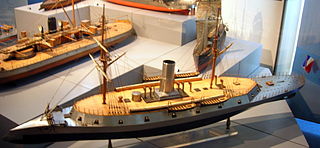
USS Dunderberg, which is a Swedish word meaning "thunder(ing) mountain," was an ocean-going casemate ironclad of 14 guns. She resembled an enlarged, two-masted version of the Confederate casemate ironclad CSS Virginia. She was originally designed to have both gun turrets and a casemate but the turrets were deleted while the ship was still being built. Construction began in 1862, but progress was slow and she was not launched until after the end of the American Civil War in 1865.

HMS Dreadnought was an ironclad turret ship built for the Royal Navy during the 1870s. Construction was halted less than a year after it began and she was redesigned to improve her stability and buoyancy. Upon completion in 1879, the ship was placed in reserve until she was commissioned in 1884 for service with the Mediterranean Fleet. Upon her return 10 years later, she became a coast guard ship in Ireland for two years. The ship then became a depot ship in 1897 before she was reclassified as a second-class battleship in 1900. Dreadnought participated in the annual fleet manoeuvres for the next two years before she became a training ship in 1902. The ship was taken out of service three years later and sold for scrap in 1908.
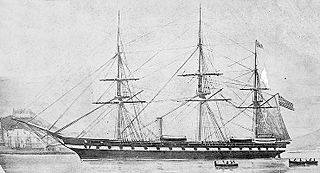
USS Roanoke was a wooden-hulled Merrimack-class screw frigate built for the United States Navy in the mid-1850s. She served as flagship of the Home Squadron in the late 1850s and captured several Confederate ships after the start of the American Civil War in 1861. The ship was converted into an ironclad monitor during 1862–63; the first ship with more than two gun turrets in history. Her conversion was not very successful as she rolled excessively and the weight of her armor and turrets strained her hull. Her deep draft meant that she could not operate off shallow Confederate ports and she was relegated to harbor defense at Hampton Roads, Virginia for the duration of the war. Roanoke was placed reserve after the war and sold for scrap in 1883.
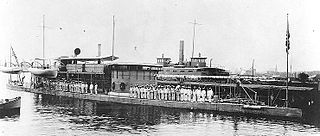
Originally named USS Tippecanoe, after the river in Indiana, USS Wyandotte was a single-turreted Canonicus-class monitor built for the Union Navy during the American Civil War. Completed after the end of the war, Wyandotte was laid up until 1876, although she received her new name in 1869. The ship was commissioned in 1876 and assigned to the North Atlantic Squadron for the next three years. She became a receiving ship in 1879 until she was placed in reserve again in 1885. Wyandotte was on militia duty when the Spanish–American War began and she was recommissioned in 1898 to defend Boston, Massachusetts from any Spanish raiders. The ship was decommissioned after the end of the war and sold for scrap in 1899.
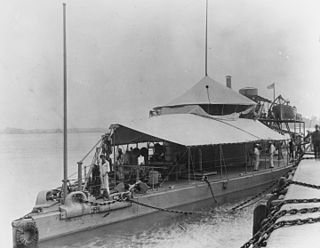
Originally named USS Manayunk, after a town in Pennsylvania, USS Ajax was a single-turreted Canonicus-class monitor built for the Union Navy during the American Civil War. Completed after the end of the war, Ajax was laid up until 1871, although she received her new name in 1869. The ship was briefly activated in 1871 before a much longer commission began in 1874–75. She was assigned to the North Atlantic Squadron during this time. Ajax was again placed in reserve in 1891. The ship was on militia duty when the Spanish–American War began and she was recommissioned in 1898 to defend Baltimore, Maryland, although she was decommissioned later in the year before the necessary refit could be completed. Ajax was sold for scrap in 1899.

HMS Ajax was the name ship of her class of ironclad battleships built for the Royal Navy during the 1870s. Completed in 1883, she was immediately placed in reserve until 1885 when the ship was commissioned for the first time. Later that year, Ajax was assigned as a coast guard ship in Scotland and remained there for the next six years. She was reduced to reserve again in 1891 and was taken out of service a decade later. The ship was sold for scrap in 1904 and subsequently broken up.
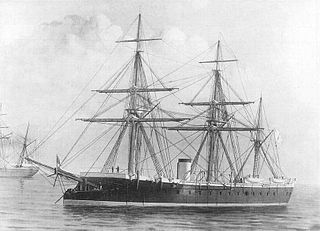
The Russian ironclad Sevastopol was ordered as a 58-gun wooden frigate by the Imperial Russian Navy in the early 1860s, but was converted while under construction into a 32-gun armored frigate. She served in the Baltic Fleet and was reclassified as a training ship in 1880. Sevastopol was decommissioned five years later, but was not sold for scrap until 1897.

Smerch was a monitor built for the Imperial Russian Navy in the early 1860s. She was designed by the British shipbuilder Charles Mitchell and built in Saint Petersburg. The ship spent her entire career with the Baltic Fleet. She ran aground and sank shortly after she entered service in 1865. Smerch was refloated and repaired shortly afterwards. She became a training ship sometime after 1892 and was stricken from the Navy List in 1904. The ship was hulked five years later and renamed Blokshiv No. 2. She was in Finland when that country declared its independence in 1918, but was returned to the Soviets after the Treaty of Brest-Litovsk was signed. Blokshiv No. 1, as the ship was now known, was sunk by German artillery fire in 1941. She was salvaged the following year and remained in service until she was stricken in 1959 and subsequently broken up.

Bronenosets was a Uragan-class monitor built for the Imperial Russian Navy in the mid-1860s. The design was based on the American Passaic-class monitor, but was modified to suit Russian engines, guns and construction techniques. The ship was only active when the Gulf of Finland was not frozen, but very little is known about her service. She was stricken in 1900 from the Navy List, converted into a coal barge in 1903 and renamed Barzha No. 324. The ship was lost in a storm sometime during World War I.

Koldun was an Uragan-class monitor built for the Imperial Russian Navy in Belgium in the mid-1860s. The design was based on the American Passaic-class monitor, but was modified to suit Russian engines, guns and construction techniques. She was one of two ships of the class to be built in Belgium and assembled in Russia. Spending her entire career with the Baltic Fleet, the ship was only active when the Gulf of Finland was not frozen, but very little is known about her service. She was stricken in 1900 from the Navy List, converted into a coal barge in 1903 and renamed Barzha No. 324. Abandoned by the Soviets in Finland in 1918, the ship was later scrapped by the Finns.
Veshchun was an Uragan-class monitor built for the Imperial Russian Navy in Belgium in the mid-1860s. The design was based on the American Passaic-class monitor, but was modified to suit Russian engines, guns and construction techniques. She was one of two ships of the class to be built in Belgium and assembled in Russia. Spending her entire career with the Baltic Fleet, the ship was only active when the Gulf of Finland was not frozen, but very little is known about her service. She was stricken in 1900 from the Navy List, converted into a coal barge in 1903 and renamed Barzha No. 44 then Barzha No. 327. Abandoned by the Soviets in Finland in 1918, the ship was later scrapped by the Finns.

Uragan was the name ship of her class of 10 monitors built for the Imperial Russian Navy in the mid-1860s. The design was based on the American Passaic-class monitor, but was modified to suit Russian engines, guns and construction techniques. Spending her entire career with the Baltic Fleet, the ship was only active when the Gulf of Finland was not frozen, but very little is known about her service. She was stricken in 1900 from the Navy List, converted into a coal barge in 1903 and renamed Barzha No. 39, then Barzha No. 52 and finally Barzha No. 325. Abandoned by the Soviets in Finland in 1918, the ship was later scrapped by the Finns.

Perun was an Uragan-class monitor built for the Imperial Russian Navy in the mid-1860s. The design was based on the American Passaic-class monitor, but was modified to suit Russian engines, guns and construction techniques. Spending her entire career with the Baltic Fleet, the ship was only active when the Gulf of Finland was not frozen, but very little is known about her service. Perun was struck from the Navy List in 1900 and became a pilot ship. Renamed Lotsiia (Pilot) in 1915, the ship was damaged during the Kronstadt rebellion of 1921 and laid up afterwards. She was run aground by a flood three years later and then her wreck was scrapped.

Latnik was an Uragan-class monitor built for the Imperial Russian Navy in the mid-1860s. The design was based on the American Passaic-class monitor, but was modified to suit Russian engines, guns and construction techniques. She was one of two ships of the class to be built in Belgium and assembled in Russia. Spending her entire career with the Baltic Fleet, the ship was only active when the Gulf of Finland was not frozen, but very little is known about her service. She was stricken in 1900 from the Navy List, converted into a coal barge in 1903 and renamed Barzha No. 38 and then Barzha No. 326. Abandoned by the Soviets in Finland in 1918, the ship was later scrapped by the Finns.

Edinorog was one of 10 Uragan-class monitors built for the Imperial Russian Navy in the mid-1860s. The design was based on the American Passaic-class monitor, but was modified to suit Russian engines, guns and construction techniques. Spending her entire career with the Baltic Fleet, the ship was only active when the Gulf of Finland was not frozen, but very little is known about her service. She was struck from the Navy List in 1900, converted into a storage hulk for mines in 1912 and renamed Blokshiv No. 4. The ship survived World War II and was stricken in 1957, although her ultimate fate is unknown.

The Kalamazoo-class monitors were a class of ocean-going ironclad monitors begun during the American Civil War. Unfinished by the end of the war, their construction was suspended in November 1865 and the unseasoned wood of their hulls rotted while they were still on the building stocks. If the four ships had been finished they would have been the most seaworthy monitors in the US Navy. One was scrapped in 1874 while the other three were disposed of a decade later.
The Milwaukee-class monitors were a class of four riverine ironclad monitors built during the American Civil War. Several supported Union forces along the Mississippi River in mid-1864 before participating in the Battle of Mobile Bay in August. Chickasaw and Winnebago bombarded Confederate coastal fortifications during the battle and during subsequent operations as well as engaging the ironclad Tennessee II. The other two ships arrived at Mobile Bay after the battle and all four supported the land attacks on Mobile in March–April 1865. Milwaukee struck a torpedo during this time and sank. The surviving three ships were sold in 1874; Chickasaw was converted into a ferry and survived until 1944 when she was scuttled. Her wreck was discovered in 2004.

The Russian monitor Charodeika was the lead ship of her class of monitors built for the Imperial Russian Navy in the 1860s. She served for her entire career with the Baltic Fleet, mostly as a training ship. She was decommissioned in 1907, but was not broken up until 1911–12.
















